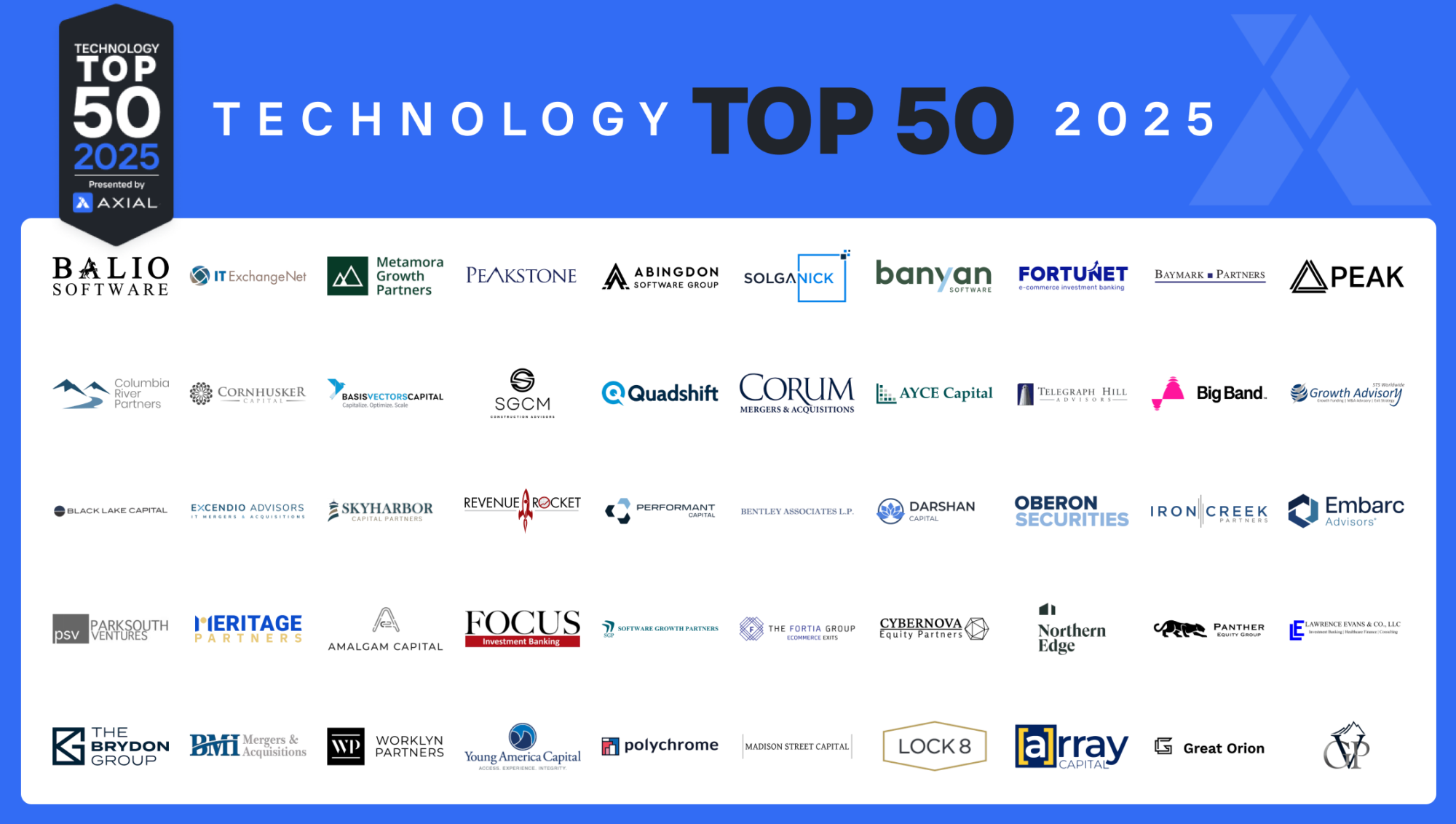
The Top 50 Lower Middle Market Technology Investors & M&A Advisors [2025]
Technology remains a steady presence in the lower middle market, representing ~13% of deals brought to market via Axial over…
We recently held the inaugural webinar for the Vistage Deal Network, a collaboration by Axial and Vistage, the leading CEO peer network, that brings together CEOs with a shared interest in pursuing deals.
Axial’s Sam Jacobs led a compelling discussion of the key trends driving evolution and increased activity in middle market deal making. Alongside these trends, traditional and emerging middle market participants are changing the way they approach business development, deal sourcing, and relationship building.
Below are the four major trends redefining the middle market and its participants below. You can check out the slideshow from the webinar, as well.
There are more types of capital and more options currently available than ever before due to regulatory changes, industry shifts, and technology infrastructure and development. Because of the greater availability of capital across the board, many middle market participants are more able to complete a transaction. This is a particularly important trend for exiting CEOs.
One of the most important regulatory changes contributing to this development was Title II of the Jobs Act, enacted in October of 2013. The ruling has changed the environment for middle market dealmaking by removing the ban on general solicitation. In the wake of this regulatory change, advisors and owners of companies are now able to more generally solicit potential accredited investors around investments in their companies and institutional investors are able to raise funds for more sources. This has opened the door for many new entrants into the private capital markets and a greater general availability of capital.
Because of competitive pressures in the top end of the market, meaning transactions larger than $100m or $200m, large cap institutional investors are moving downmarket, looking at smaller and smaller companies to invest in or acquire. Whereas before their LPs may have had preferences that would prohibit them from doing deals smaller than a certain size, they are now open, available, and interested in investing in companies that are much smaller than they have traditionally been.
This in turn is putting pressure on the bulge bracket investment banking, creating more and more M&A advisory firms and boutique firms focused on the middle market, again, new participants that hadn’t previously been there.
Meanwhile, emerging technology platforms, like Axial, are creating new opportunities for participants to do research, to connect, and to understand the dynamics of the middle market. The consequence of all of this, is the overall democratization of capital. No longer is it just the very large private equity firms firms, bulge bracket banks and major corporations participating in the middle market, it’s anyone’s game.
While the middle market has always been very fragmented, the new entrants propelled forth by the democratization of capital is only accelerating the trend. Some of these new players, including family offices, search funds and individual investors, have been armed with some of the same tools and platforms that the “old guard” – private equity firms, investment banks, and strategic buyers – had exclusively in years past.
According to Palico, the first couple months of 2015 have seen an all time high for private firms seeking capital – 2,209 funds are currently being raised. Data from Sutton Place Strategies cites that 796 different sell side M&A advisors closed a deal in 2014. Of those, 309 were not active at all the previous year – either they didn’t exist or they didn’t close a deal. This means that as a seller or buyer of a company if you relied on the most comprehensive and current list of active advisors in 2013 to build your strategies from, you were still missing out on 40% of the market. We’re also seeing an increasing number of corporate acquirers outside of Fortune 1000 firms consider acquisitions of smaller companies to power their growth strategy.
Because of the competition that is heating up the middle market, and the need to stand out amongst a leveling playing field of participants, a renewed focus on specialization is beginning to take hold amongst capital providers and advisors. A 2007 study by Robert Cressy, Fredrico Munari and Alessandro Malipiero showed that specialized firms on average yield 4% higher operating profit than non-specialized firms. They cite “reduced information asymmetries and reduced uncertainties” as the two main sources of advantage for specialization.
Private equity firms that are more specialized than their competitors possess a deeper knowledge of their competitive environment and can therefore both select potentially superior performers as well as provide more effective monitoring and advice. As a point of differentiation, a way to drive superior returns, and an immediate enhancement to the overall transaction process, specialization is becoming absolutely critical for firms who wish to maintain a competitive advantage.
Technology will Bridge the Gap
According to our own research, 89% of CEOs start their research and evaluation of a business or financial partner online, before they accept a meeting or engage in a conversation. Platforms like LinkedIn and Axial, coupled with more traditional media and research databases, are synthesizing this trend.
But, technology is most importantly surfacing previously unknown relationships and opaque information for the common CEO. This is not the first time technology has transformed transactional markets. From eBay to Zillow to Axial, starting with simple, consumer markets and small dollar amount transactions, the internet is now evolving and impacting much more complex markets and supporting larger dollar amount transactions to occur online.
In dealmaking, technology is overtaking all aspects of the middle market as a key resource and tool that helps CEOs understand and identify all of their different options.
Check out more on the players in the middle market, their key characteristics, how to evaluate them, and understand how changes to the industry are impacting them in the below webinar: